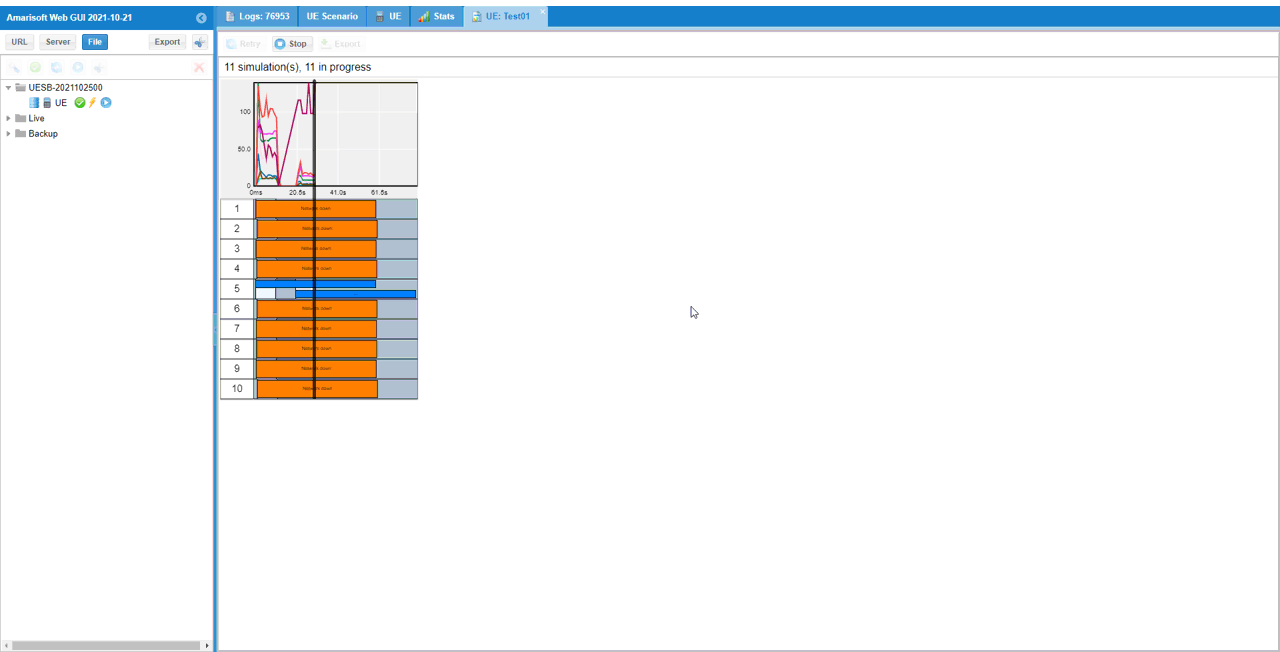UEsim Scenario
This tutorial shows how to define and perform various sequence of test procedure using WebGUI. You may consider this as a kind of batch procedure defined for each UE simulated by UEsim. This predefined test procedure in WebGUI is called Scenario. This feature is especially usefull for simulating multiple UEs. There are many different things you can configure. Some of the most basic and commonly used configuration is as follows. These are only some important configurations. There are many other parameters that are not listed here.
- The number of UE to be created (simulated)
- USIM parameters for each of the UEs
- Power-on Timing : You may choose on whether you want to power on all the UEs at the same time or power on one by one with a certain time interval etc.
- Thing to do after the initial attach : You can define various tasks about what you want to do after the completion of the initial attach like Ping, UDP, Flooding, RTP etc.
- Display of UE status : Once the scenario is configured and run, WebGUI shows various information of each and every UE like connection status, rsrp, data rate etc.
Table of Contents
Introduction
In modern mobile network testing and validation, the ability to simulate multiple User Equipments (UEs) under varied and complex operational scenarios is crucial for evaluating network performance, robustness, and scalability. UEsim is an advanced UE simulator platform designed to facilitate these requirements by offering an extensive set of configuration and automation tools accessible through an intuitive WebGUI interface. Central to this platform is the concept of a Scenario, a predefined sequence of test procedures tailored for each simulated UE. Scenarios enable automated, reproducible batch testing, allowing users to configure diverse aspects such as USIM parameters, network attach sequences, data traffic generation, and device behavior after connection establishment. Architecturally, UEsim is structured to manage multiple virtual UEs concurrently, leveraging web-based orchestration for real-time monitoring, status visualization, and detailed test control. This approach significantly streamlines the process of large-scale test case execution, supports rapid prototyping, and enhances the reliability of results by minimizing manual intervention. By integrating scenario-based automation with comprehensive configuration options, UEsim plays a pivotal role in the end-to-end validation of 4G/5G core and radio access networks, contributing to the accelerated deployment and improved quality assurance of next-generation mobile services.
-
Technology and Platform Context
- UEsim provides a high-fidelity simulation environment for emulating large numbers of UEs.
- The WebGUI offers a centralized interface for defining, executing, and monitoring complex test scenarios.
- Scenario-based testing automates workflows, minimizing manual setup and reducing the risk of human error.
-
Relevance and Importance of Tutorial Topic
- Efficient scenario creation and execution is vital for thorough network validation and troubleshooting.
- Automated scenario workflows enhance repeatability and scalability in testing, supporting both functional and performance assessments.
- This tutorial empowers network engineers and QA teams to simulate real-world UE behaviors, enabling robust network evaluation.
-
What Learners Will Gain
- Understanding of scenario structure and key configuration parameters in UEsim WebGUI.
- Ability to define and execute automated test procedures for multiple UEs.
- Skills to monitor, interpret, and troubleshoot scenario execution outcomes via the WebGUI dashboard.
- Insights into best practices for scalable and reproducible network testing.
-
Prerequisite Knowledge or Skills
- Familiarity with basic mobile network concepts, including UE, core network, and attach processes.
- Basic understanding of network testing principles and objectives.
- Prior exposure to web-based management interfaces is beneficial but not mandatory.
Summary of the Tutorial
This tutorial outlines two comprehensive test procedures for LTE multi-UE simulation using a callbox and UE simulator environment. The tutorial is structured into setup, configuration, and step-by-step methodologies for executing an Attach test and a Ping test.
-
Test Setup and Configuration:
- Utilizes a SIM card provided with the system as default. Configuration changes can be referenced in the Configuration Guide.
- Configurations involve use and modification of default files:
- ue.default-multi-ue.cfg (for multi-UE scenarios, copied and modified from ue.default.cfg).
- enb.default.cfg for eNB setup.
- mme-ims-multi-ue.cfg and ue_db-ims-multi-ue.cfg for MME and UE database settings, ensuring parameter consistency (e.g., IMSI and K value) across entities.
- On the callbox side, main LTE radio and network parameters (such as TDD mode, N_RB_DL, N_ANTENNA_DL) can be configured as required, provided UE connectivity is unaffected.
- For extended RRC connection, the inactivity_timer in enb.default.cfg is set to a large value.
- In ue.default-multi-ue.cfg, UE_COUNT is set to 5 for multi-UE simulation; note that WebGUI settings can override certain parameters like multi_ue and ue_count.
-
Test 1: Attach Procedure
- Access the UE sim WebGUI and navigate to the [UE Scenario] tab.
- Create a new scenario by clicking the [+Add] button, opening a panel with default settings.
- Specify the scenario name and UE count, then apply changes.
- Within the 'Create UEs' tab, configure relevant parameters such as:
- Count, IMSI, Cell list, RAT, AS Release, Category, Forced RI, Forced CQI, Algorithm, K, Response length, Type, PDSCH Max decoder iteration
- In the 'Power on/off' configuration, set power conditions for each UE (e.g., power on/off duration).
- Other scenario tabs (PDN, channel simulation, simulations) are left at default for this basic test.
- Ensure LTE service is running in the background, then initiate the test by clicking the [Run] button.
-
Monitoring:
- Use the Test tab to view ongoing test status, number of UEs, and call status per UE in graphical mode.
- Use the UE tab to check call status, activation, and RRC/EMM status for each UE in tabular form.
-
Test 2: Ping Procedure
- This test builds upon the Attach scenario from Test 1; ensure the Attach test is working before proceeding.
- With previous configurations intact, adjust the [Simulation] section for this test.
- Add a simulation script by clicking the [+] button, which opens a dialog to select simulation types such as ICMP PING, UDP, RTP, VOIP, Flood, HTTP transfer, Application, etc.
- Select ICMP PING for this test, specify the script name, and add the script.
- Configure script parameters, including:
- Probability, APN, Start Delay, Duration, Payload size, Delay, Destination
- Apply changes and start the test by clicking the [Run] button.
-
Monitoring:
- Graphically monitor UE data traffic and activity under the simulation scenario.
The tutorial emphasizes the importance of parameter consistency across configurations and proper scenario setup in the WebGUI. Tests are monitored through graphical and tabular interfaces, allowing for real-time observation of multi-UE attach and data (ping) scenarios.
Test Setup
Test setup for this tutorial is as shown below.
- SIM Card used in this tutorial is the one delivered with the system as it is.
- If you want to change the configuration, The tutorial Configuration Guide would help
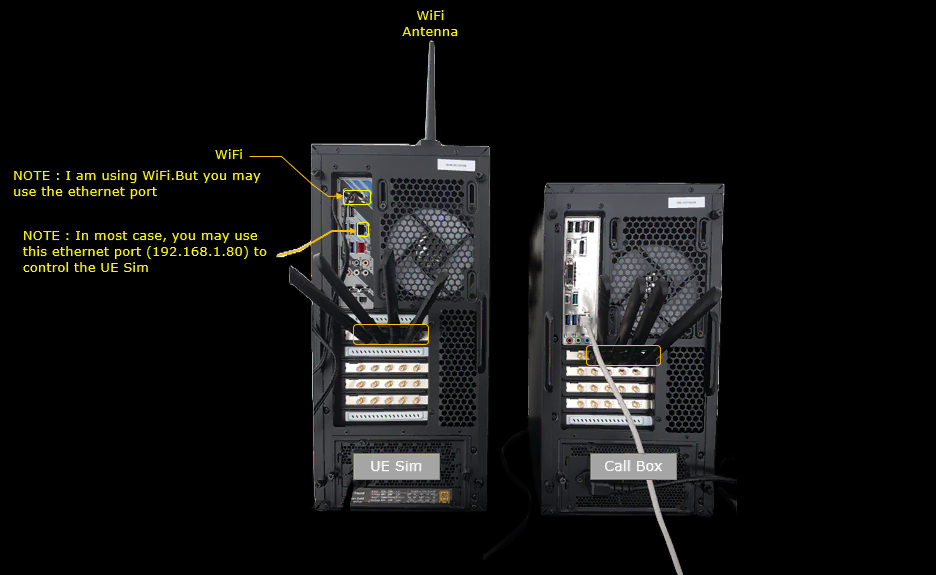
Configuration
I used the ue.default-multi-ue.cfg which is copied and modified from ue.default.cfg (LTE default configuration).

I used the enb.default.cfg (LTE default configuration).

I used the mme-ims-multi-ue.cfg which is copied and modeified from mme-ims.cfg
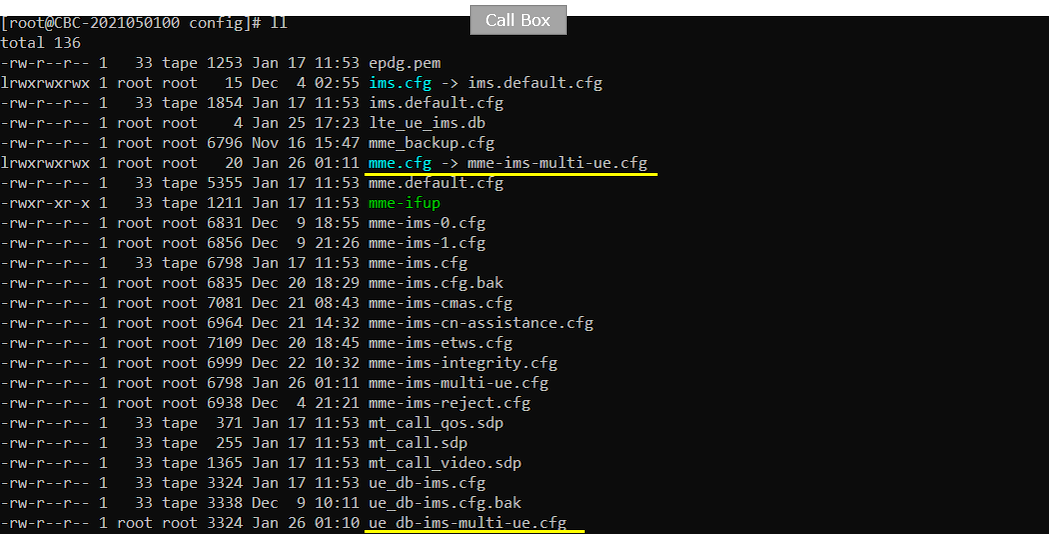
In the mme-ims-multi-ue.cfg, I changed the configuration so that ue_db-ims-multi-ue.cfg is used on Callbox.

In this tutorial, following SIM information will be used within ue_db-ims-multi-ue.cfg. Make it sure to configure the same parameters on UE side as well.

In ue.default-multi-ue.cfg on UEsim, Make it sure that imsi and K value in this file matches the value on enb side shown in previous slide

Following is the configuration in enb.default.cfg on Callbox. You can configure these (TDD, N_RB_DL, N_ANTENNA_DL etc) in anyway you like as long as it has no problem with UE connection.

This is optional. In enb.default.cfg, I made a small change as shown below. Everything is same as the default. The only thing that I changed is to put the large value for inactivity_timer to maintain the connection time before releasing RRC connection.

Following is the configuration in ue.default-multi-ue.cfg on UE sim. I set UE_COUNT to 5 for this test.

Test 1 : Attach
Connect to UE sim WebGUI and follow the procedures in following slides
In this test, I will use the default setting in most of the parameters. Only a few changes from the default setting to make a scenario creation as simple as possible
Define a Scenario and Perform the test
Select [UE Scenario] tab

Hit [+Add] button and you will get a new Scenario panel with default settings. This is to create a new Scenario pannel where you can specify various items like 'Create UEs', 'PDN','Channel Simulation', 'Power on/off' and 'Simulation'. Most of these tabs comes with default values. You only need to change values which you want to set differently from the default values.

Specify Scenario Name and UE count and hit [Apply Changes] button. In 'Create UEs' tabs, you can specify various items like 'Count', 'IMSI', 'Cell list', 'RAT', 'AS Release', 'Category', 'Forced RI', 'Forced CQI', 'Algo', 'K', 'Response length', 'Type', 'PDSCH Max decoder iteration'. For the descriptions on each of these parameters, refer to UEsim document.
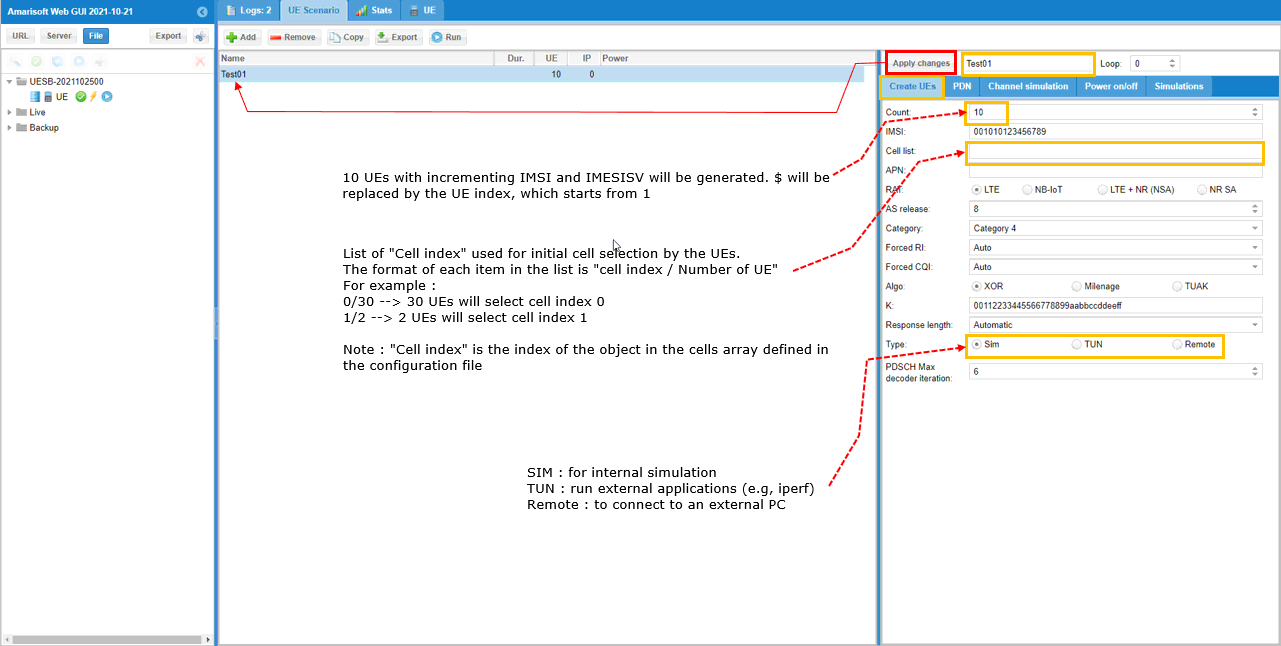
Now Set the 'Power on/off' configuration. Here you can specify on the conditions of power on/off for each UE (e.g, power on duration, power off duration etc). For the descriptions on each of these parameters, refer to UEsim document.
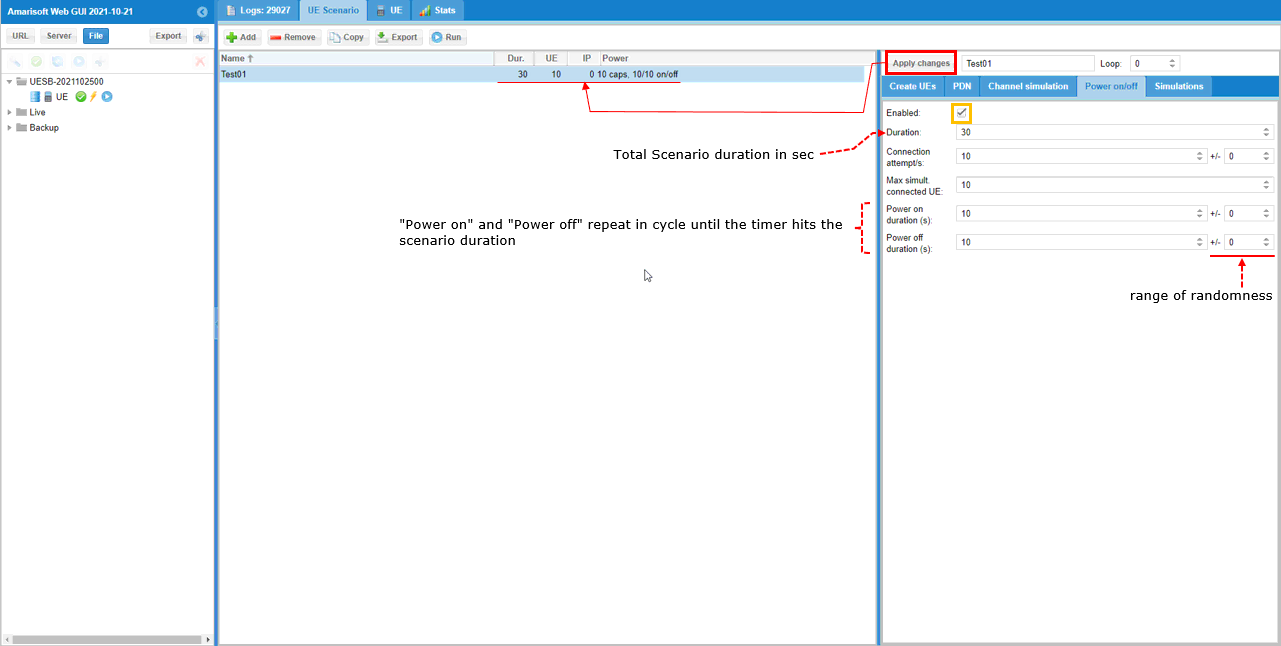
In this simple test, I would leave other configurations (PDN, channel simulation, Simulations) as it is.
Now that we configured everything as we want. Hit [Run] button (
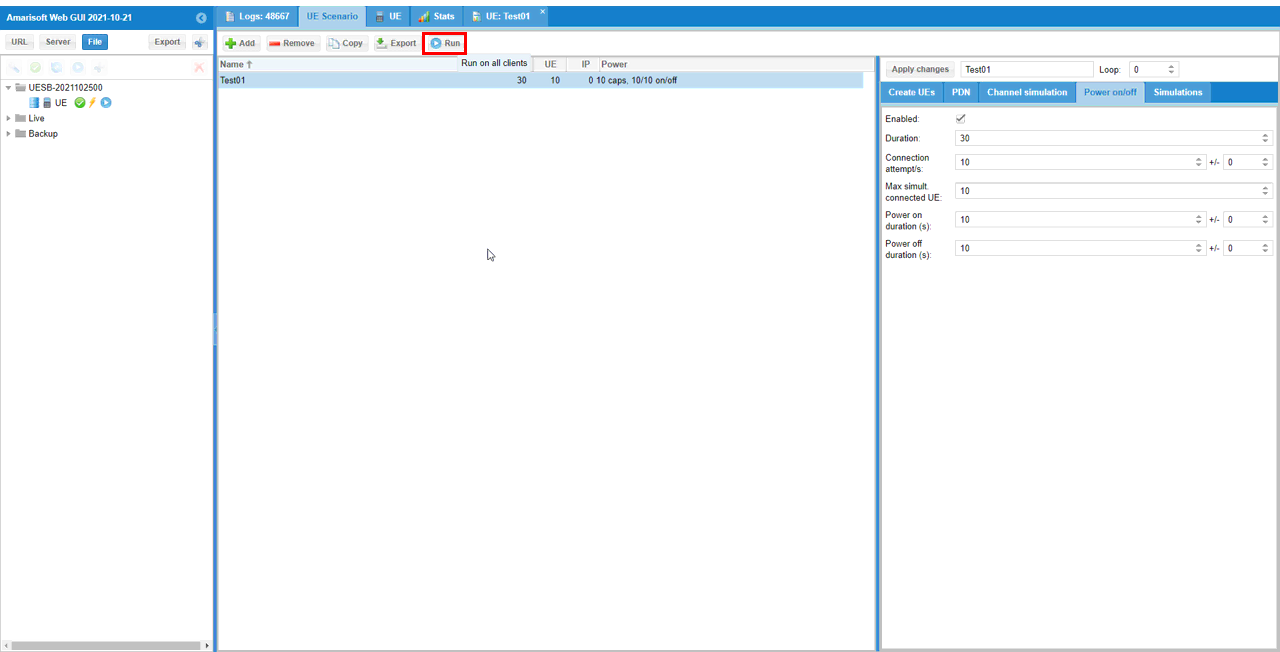
If you go to the test tab, you would see the test is on-going as shown below. In this tab, you can confirm how many UEs are being used and check the call status of each of the UEs in Graph mode

If you go to the [UE] tab, you would see call status and various plots as shown here. In this pannel, you can confirm how many UEs are activated and RRC/EMM status of each UEs and other information in tabular format.

Test 2 : Ping
This test is configured just by adding a few more configuration to Test 1. So make it sure that you have the Test1 scenario working (
Define a Scenario and Perform the test
With all other configuration as set in previous test, let's set [Simulation] part for this test.

Add Simulation functionality(script) by hitting [+] button. It will popup a dialog where you can select various types of simulation like 'ICMP PNG', 'UDP', 'RTP', 'VOIP', 'Flood', 'HTTP transfer' and 'Application' etc. In this test, I will use 'ICMP PING'.

Specify the script name as you like and hit [Add script] button.
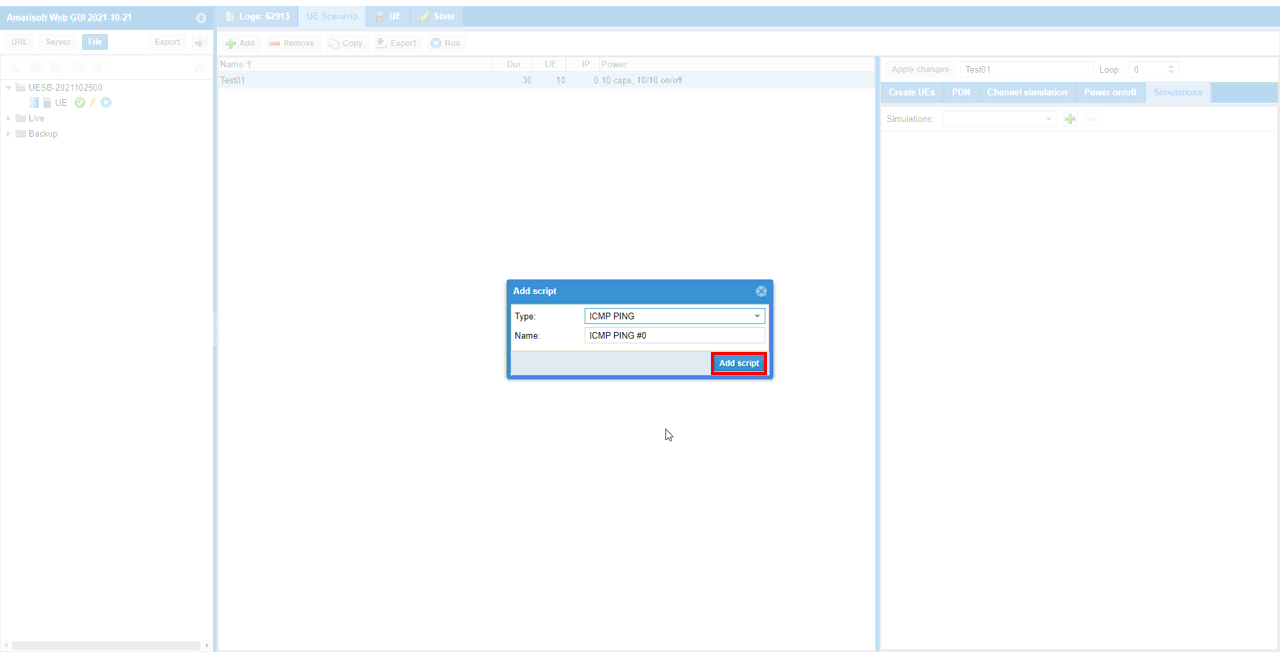
Now specify the details of the script that you selected like 'Probability', 'APN', 'Start Delay', 'Duration', 'Payload size', 'Delay', 'Destination' etc and hit [Apply changes]. For the descriptions on each of these parameters, refer to UEsim document.
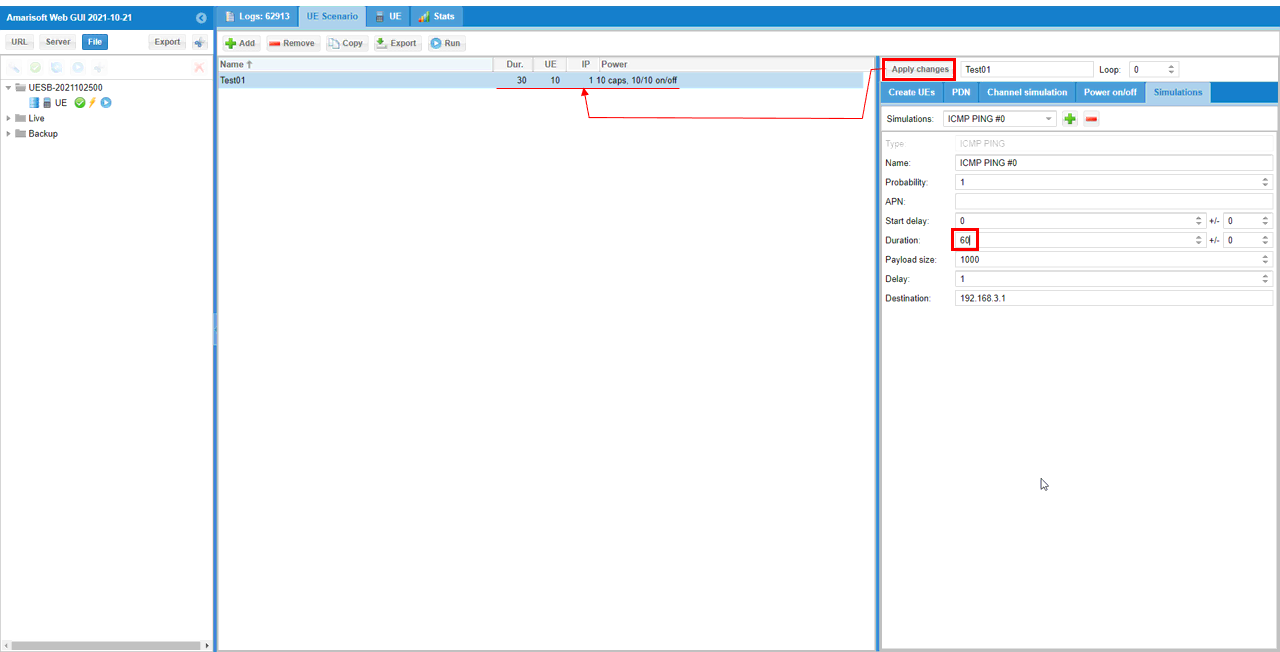
Now that the configuration is done as intended, hit [Run] button.
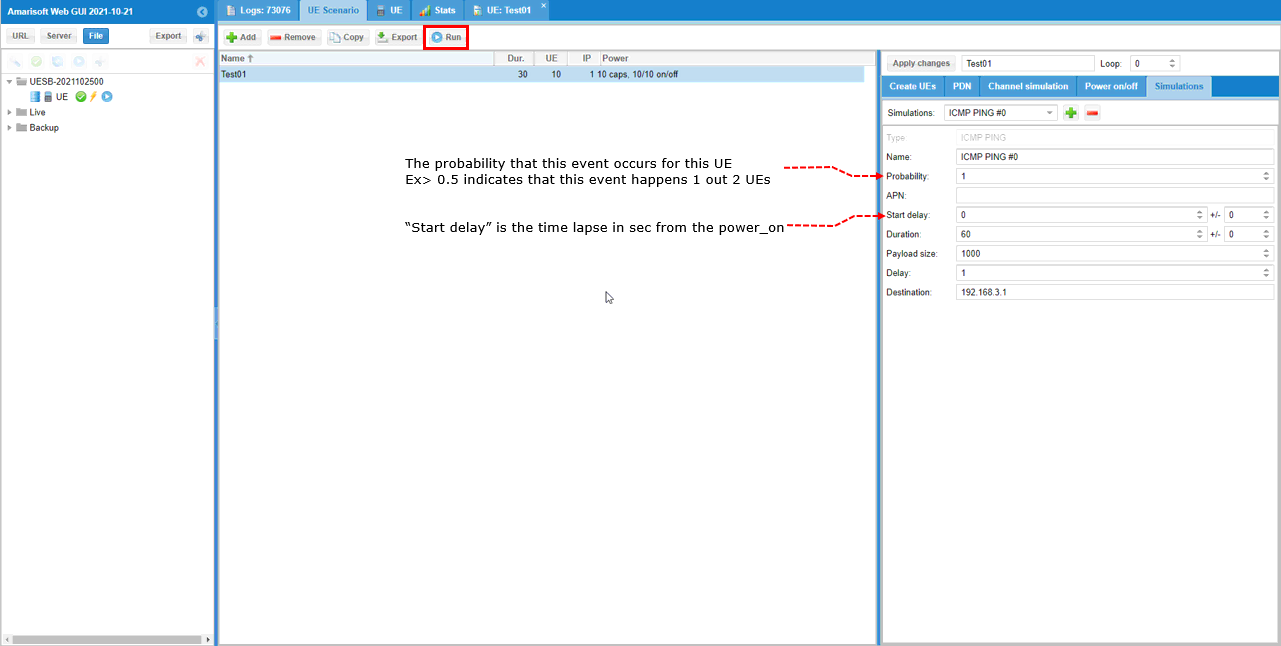
Now you can check out graphically how all the UE is doing with the data traffic
